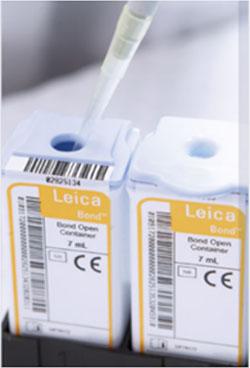
The BOND RX Stainer - Automated Multiplexing Solutions

Multiplex immunohistochemistry is fast becoming a useful research tool as it enables a more in-depth analysis of precious tissue samples. This is often associated with increased labor in the laboratory; however, the BOND RX stainer can automate your multiplex solutions to give you more freedom to discover.
Identifying disease biomarkers and effective therapeutic targets requires research that delves into increasingly fine molecular detail. To add to the complexity of molecular biology, we understand that all molecular events do not work in isolation. All events, whether at the gene or protein level, homeostatic or pathogenic will influence many other cell types, cascading to tissue and organ function. Tissue samples are a valuable resource to better understand these mechanisms as they hold genetic, protein and tissue biology, however, these samples can often be a limited resource.

Aside from time, automated multiplexing conserve the integrity of precious and limited tissue samples to answer an overarching research question. For example, you may want to investigate the expression of novel biomarkers as well as analyzing the infiltration of specific immune cell lineages in tumor samples as part of a research project. Multiplex IHC/ISH has the potential to identify all markers of interest on one tissue section, thus maximizing the amount of biological information acquired for a more in-depth analysis and understanding.
To accompany this, the BOND RX stainer also allows you to automate your unique and customized staining protocols. If you are using locked-nucleic acid ISH, interested in circulating tumor cells or immunofluorescent multiplexing, then there is no need to modify and/or reoptimize your tests. This system enables these tests, allowing you a personalized approach to biomarker/drug discovery.
Automating multiplex IHC/ISH therefore combines more freedom with efficient use of important tissue samples that ultimately results in more opportunities to unfold the story of complex diseases.
Here are some example articles that have used the BOND RX stainer for real-life research applications for specific investigations:
CSF1R Ligands IL-34 and CSF1 Are Differentially Required for Microglia Development and Maintenance in White and Gray Matter Brain Regions.1
Investigating Radiotherapy Response in a Novel Syngeneic Model of Prostate Cancer.2
RX-5902, a novel beta-catenin modulator, potentiates the efficacy of immune checkpoint inhibitors in preclinical models of triple negative breast cancer.3
To enhance those research discoveries, below is a summary of key features of the BOND RX stainer:
- Speed: Stain 2-6 markers on 30 slides in as little as 2.5 hours, reducing time performing manual staining steps, and increasing time for innovation.
- Flexibility: 3 trays means 3 experiments run simultaneously to help answer those all-important research questions.
- Customization: Automate your own tests and tailor the BOND RX stainer to perform fully customized protocols with specific incubation times, temperatures, and every step of your multiplex staining. Yes, every step!
- IHC and ISH : Run IHC and ISH on the same sample in the same run to understand the spatial relationship between gene expression and cellular phenotype.

- Fluorescent or chromogenic: Fluorescent and chromonic detection are both possibilities on the BOND RX stainer for up to 6 markers – Take your pick!
- Open System: Use your own antibodies, probes, amplification, and detection systems with the open container system.
- Consistency: The covertile function ensures consistent reagent application with minimal, yet sufficient reagent volume. No more parafilm!
- Efficiency: Generate minimal waste and access all bulk reagents at any time (yes, even when the experiment is running). Low reagent volumes are also visibly highlighted during the run.

Want to know more? Read more here or contact us for more information.
Start innovating today!

발표자 소개

Rhian is a Scientist from Swansea University in Medical and Healthcare Studies and was featured in several collaborative publications. Rhian’s research-based background focused on tissue-based pathology in Multiple Sclerosis, primarily using immunohistochemical analysis and in vitro molecular techniques. She spent a short period conducting routine PCR testing for COVID-19 at the end of 2020.
참조 문헌
- Easley-Neal C, Foreman O, Sharma N, Zarrin A.A, Weimer R.M. CSF1R Ligands IL-34 and CSF1 Are Differentially Required for Microglia Development and Maintenance in White and Gray Matter Brain Regions. Front. Immunol. 2019;10:2199.
- Haughey CM, Mukherjee D, Steele RE, et al. Investigating Radiotherapy Response in a Novel Syngeneic Model of Prostate Cancer. Cancers. 2020;12(10):2804.
- Tentler JJ, Lang J, Capasso A, et al. RX-5902, a novel β-catenin modulator, potentiates the efficacy of immune checkpoint inhibitors in preclinical models of triple-negative breast Cancer. BMC Cancer. 2020;20:1063.
Related Content
Leica Biosystems 콘텐츠는 Leica Biosystems 웹사이트 이용 약관의 적용을 받으며, 이용 약관은 다음에서 확인할 수 있습니다. 법적고지. 라이카 바이오시스템즈 웨비나, 교육 프레젠테이션 및 관련 자료는 특별 주제 관련 일반 정보를 제공하지만 의료, 규정 또는 법률 상담으로 제공되지 않으며 해석되어서는 안 됩니다. 관점과 의견은 발표자/저자의 개인 관점과 의견이며 라이카 바이오시스템즈, 그 직원 또는 대행사의 관점이나 의견을 나타내거나 반영하지 않습니다. 제3자 자원 또는 콘텐츠에 대한 액세스를 제공하는 콘텐츠에 포함된 모든 링크는 오직 편의를 위해 제공됩니다.
모든 제품 사용에 다양한 제품 및 장치의 제품 정보 가이드, 부속 문서 및 작동 설명서를 참조해야 합니다.
Copyright © 2025 Leica Biosystems division of Leica Microsystems, Inc. and its Leica Biosystems affiliates. All rights reserved. LEICA and the Leica Logo are registered trademarks of Leica Microsystems IR GmbH.


